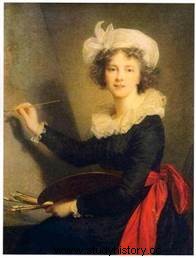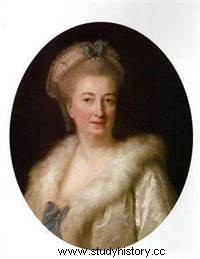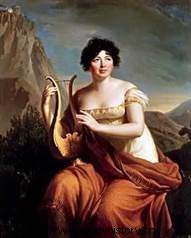 Élisabeth Vigée Le Brun , an illustrious painter, of world renown, was best known for her portraits of Marie Antoinette, Queen of France. As a child, she had a gift for drawing; as a young girl, she produced her first portrait at the age of 15; young woman, she entered the Royal Academy of Painting at the age of 25 and became the Queen's official painter. A meteoric rise that will take her to Saint Petersburg with Empress Catherine II.
Élisabeth Vigée Le Brun , an illustrious painter, of world renown, was best known for her portraits of Marie Antoinette, Queen of France. As a child, she had a gift for drawing; as a young girl, she produced her first portrait at the age of 15; young woman, she entered the Royal Academy of Painting at the age of 25 and became the Queen's official painter. A meteoric rise that will take her to Saint Petersburg with Empress Catherine II.
Elisabeth Vigée’s youth
Born on April 16, 1755, from a painter father, she entered the convent on rue de Charonne at the age of 5 to be educated there like all the little bourgeois girls of her age, and to distract herself she draws. Returning to her parents at 11, she is very happy to be able to use her father's pencils. The latter giving lessons to improve his income, Elisabeth sneaks into the back of the play and attends. Her father notes with joy that she is very gifted. But this family joy is quickly extinguished when her father dies from a lost bone in the stomach, we are in 1768, she is only 13 years old.
Dean, friend of her father, history painter, pushes her to take up her pencils; a year later, she enrolled at Briard, which had a studio in the Louvre. These two painters had had the same master Carle Van Loo. There, she met Joseph Vernet (56 years old, recognized at court thanks to Louis XV who entrusted him with the paintings of French ports). Vernet, very attracted by this young talent, encouraged him to study nature and to look into Flemish and Italian art.
 She produced her first masterpiece in 1770:the portrait of her mother… and we talk about the young girl all over Paris. Soon the ladies of the court visit him in his studio, near the Royal Palace, up to Madame Geoffrin, well in court, a woman of spirit who recognizes talents. She inevitably receives orders from Madame d'Aguesseau, the Comtesse de Vieuville, the Marquis de Choiseul (Minister of Louis XV).
She produced her first masterpiece in 1770:the portrait of her mother… and we talk about the young girl all over Paris. Soon the ladies of the court visit him in his studio, near the Royal Palace, up to Madame Geoffrin, well in court, a woman of spirit who recognizes talents. She inevitably receives orders from Madame d'Aguesseau, the Comtesse de Vieuville, the Marquis de Choiseul (Minister of Louis XV).
Wise, success does not turn his head; Having become a professional painter, she scrupulously notes the paintings produced and has already counted 27 of them, she is only 18 years old.
Official painter to the Queen at Versailles
It was during a walk in Marly-le-Roi that she met Marie Antoinette. The queen smiles at him and invites him to continue his walk "where he pleases". The queen did not stop by chance, her cousin the Duchess of Chartres had long extolled the merits of Elisabeth to her.
She meets Jean Baptiste Pierre Le Brun, son of an antique dealer and self-proclaimed painting expert, who woos her, having discovered her great talent. At the insistence of his mother, Elisabeth married him in January 1776, it will be a failure as she mentions in her Memoirs "his passion for women caused the ruin of his fortune and mine, which he had entirely at his disposal".
In November 1776, Chalgrin, intendant of the Buildings of Monsieur, offered him to make the portrait of the king's brother and twelve copies. Four months later, she painted four portraits of the queen. In 1778, great personalities placed orders with him, such as the Duc de Cossé who asked him for the Comtesse du Barry.
Finally, in the spring of 1779, Elisabeth was presented to the queen; immediately “the current passes”:they have the same age, the same sweetness, the same innate grace, the same taste for music, they get along wonderfully. Elisabeth makes a first portrait of the queen in a satin dress, a rose in her hand, then two copies. Immediately, she became the favorite painter but above all the official painter of the queen.
 The paintings remain either with the king, or are sent to foreign courts, to friends…his fame is made! The whole court calls for it, so much so that it is necessary to register on a waiting list! She then began portraits from nature (whereas before she worked based on canvases already produced), such as those of the Count of Provence, of Madame Elisabeth (sister of Louis XV), then of the Princess of Lamballe and of the Comtesse de Polignac.
The paintings remain either with the king, or are sent to foreign courts, to friends…his fame is made! The whole court calls for it, so much so that it is necessary to register on a waiting list! She then began portraits from nature (whereas before she worked based on canvases already produced), such as those of the Count of Provence, of Madame Elisabeth (sister of Louis XV), then of the Princess of Lamballe and of the Comtesse de Polignac.
It was then that Joseph Vernet, who had followed her career, offered to present her to the Royal Academy of Painting "the official consecration of a talent recognized by all" …but it takes the intervention of the queen in person for her to be accepted (the Academy no longer wants new women):“peace bringing back abundance” will be exhibited at the Salon in 1780 and she will become a portraitist at the 'Academy of Saint Luke.
As early as October 1781, Marie Antoinette intended to have her children painted and did not remonstrate with her when Elisabeth was absent due to illness…they were both pregnant, they understand each other. The meetings are no longer professional, they are two women, two mothers with the joy of talking and carrying their children.
Elisabeth excels in portraits of children and women; his painting changes, the painted clothes fade away in favor of the beauty of the characters, of their human soul. In these paintings, the clothes do not hinder the body, the hairstyles are unadorned, the face is barely made up, it is a return to nature.
Naturally the queen asks him for a painting with her children. Elisabeth makes a sketch then begins her work which she wishes to present at the Salon in 1788. She represents an empty cradle:the queen is pregnant. And yet the characters do not reflect joy. Since the case of the necklace, the queen has been harmed, she has lost her child and the Dauphin is sick! The time passed between the order and the realization of the painting presented at the Salon and then exhibited in the gallery of Versailles. Every day, the queen passes by this empty cradle which should have welcomed Sophie-Hélène-Béatrice who died in mid-June 1787, and mourns the Dauphin who left in June 1789...the painting is out of place!
The world fame of Élisabeth Vigée Le Brun
The days are darkening, Elisabeth can no longer paint, no longer has a taste for her art. The population is unleashed, libels attack him being admitted to the Court; It's time to go. She opts for Italy, but despite the passport received for her daughter and her, the national guards arrest her. She then disguises herself as a worker, hidden under a big scarf and reaches the border not without difficulty, she is safe. Surprisingly, people recognize her, help her, support her. From Florence, she goes to Rome and Venice, finds friends who fled like her. There finally, she goes back to painting, realizes her self-portrait, paying homage to the queen by painting her on the canvas on the left.
 Ready to return to France in November 1791 at the express request of the deputies (on pain of confiscation of property and her civil rights), she learns of the capture of the Tuileries and the beginning of the Terror and decides to go to Austria. Installed in Vienna for some time, received at the Court, the Russian ambassador transmits to him the invitation of the Empress. She therefore went to Saint Petersburg in July 1795. There again, she did not expect such a welcome:the best Russian society sought her out, orders poured in, she never stopped painting; after the Grand Duchesses the Empress wants to pose...but she dies too quickly!
Ready to return to France in November 1791 at the express request of the deputies (on pain of confiscation of property and her civil rights), she learns of the capture of the Tuileries and the beginning of the Terror and decides to go to Austria. Installed in Vienna for some time, received at the Court, the Russian ambassador transmits to him the invitation of the Empress. She therefore went to Saint Petersburg in July 1795. There again, she did not expect such a welcome:the best Russian society sought her out, orders poured in, she never stopped painting; after the Grand Duchesses the Empress wants to pose...but she dies too quickly!
It was twelve years since she left Paris, the need to return was felt, she arrived in Paris in January 1802. The press seized on this great news, a concert is given in her honor, friends invite her but nothing is like before, she no longer finds her place in this society. She visits England, Switzerland and divides her time between the French capital and her country house in Louveciennes.
After her Memoirs in 1835, somewhat alone having lost all the members of her family, she suffered a fatal stroke on March 30, 1842.
To go further
- Louise Elisabeth Vigée Le Brun:Story of a Look, by Geneviève Haroche-Bouzinac. Flammarion, 2011.
- Memories 1755-1842:Women reigned then, the Revolution dethroned them, by Elisabeth Vigée-Le Brun. Tallandier, 2009.
- “Madame Vigée-Le Brun” Ines de Kertanguy. Perrin, 2000.
- The Fabulous Destiny of Elisabeth Vigée Le BrunElisabeth Vigée Le Brun. Arte Video, 2018.
